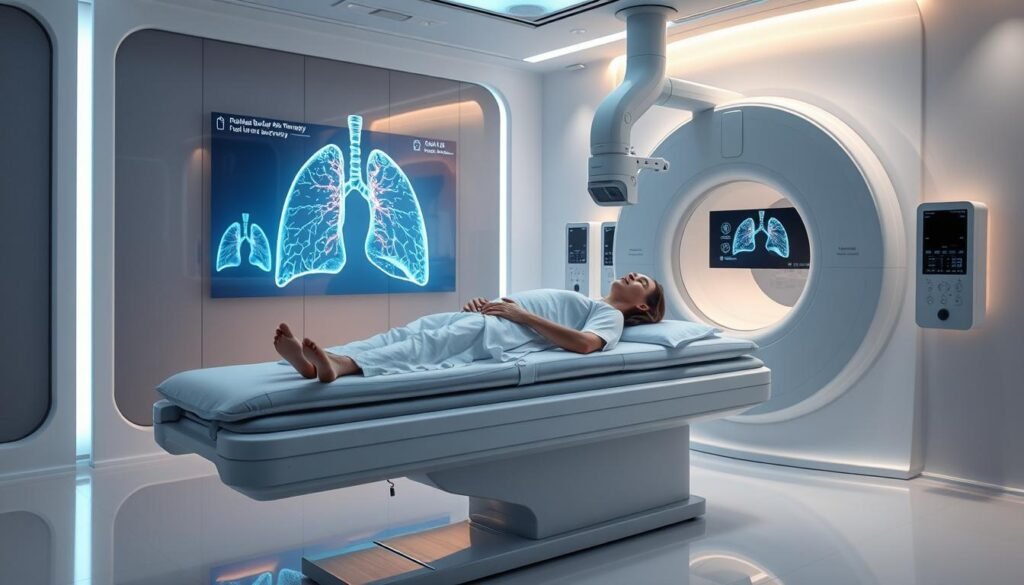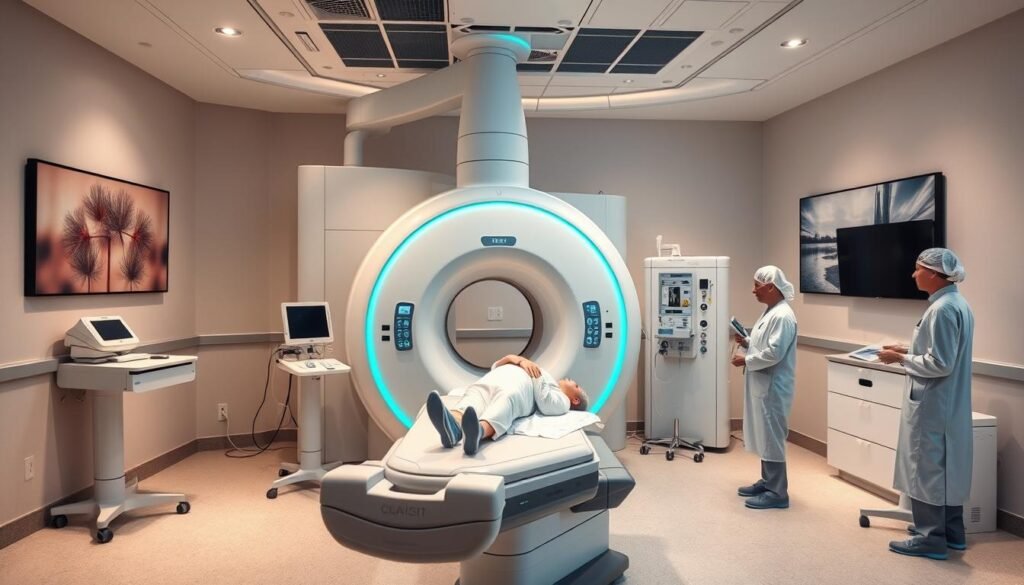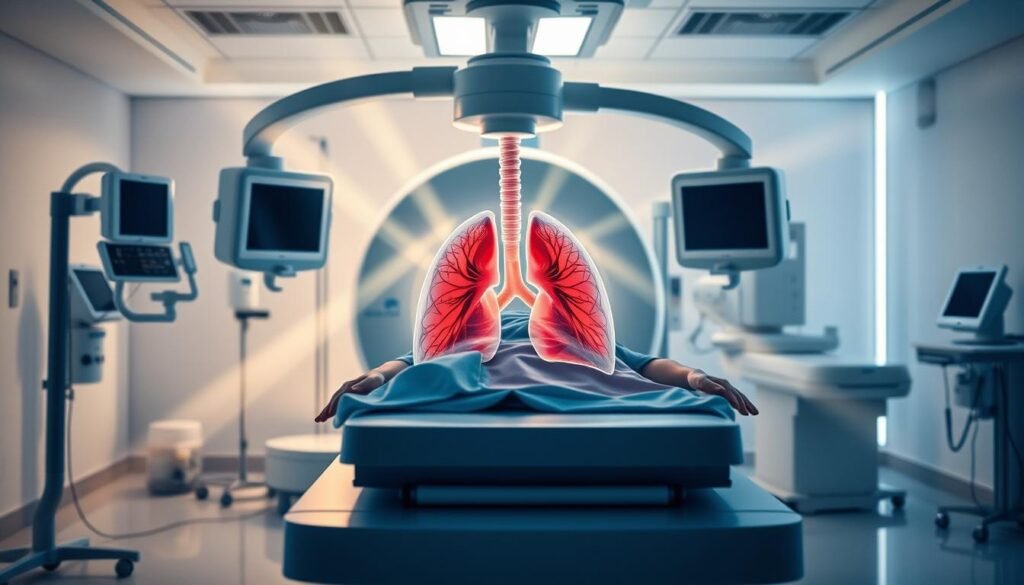Did you know that nearly half the people with lung cancer need radiation therapy? This is especially true for a type called non-small cell lung cancer. If surgery isn’t possible, radiation therapy steps in. It uses high-energy X-rays to kill cancer cells, playing a key part in fighting lung cancer.
Radiation therapy for lung cancer has different roles. It can be the main treatment, help after surgery, or relieve symptoms in late stages. The most common method is called external beam radiation therapy (EBRT). It is given five days a week, for five to seven weeks. There are also advanced techniques like Stereotactic Body Radiation Therapy (SBRT). SBRT precisely targets cancer, while protecting healthy tissues.
New treatments like proton therapy are becoming popular for Stage III non-small cell lung cancer. They’re more accurate and safer for nearby organs. Knowing about these treatments helps patients and families make informed decisions during their treatment path.
Key Takeaways
- Radiation therapy is critical for nearly 50% of lung cancer patients, especially for non-small cell lung cancer.
- Commonly used techniques include external beam radiation therapy (EBRT) and modern approaches like SBRT.
- Radiation can be utilized as primary treatment, post-surgery, or for symptom relief in advanced cases.
- Proton therapy is an emerging option that offers targeted treatment with minimized damage to surrounding organs.
- Patient care incorporates a collaborative approach among various specialists in lung cancer treatment.
- Side effects may include fatigue, nausea, and skin changes, warranting careful management strategies.
What Is Lung Cancer Radiation Therapy?
Lung cancer radiation therapy is a key treatment in medicine. It uses high-energy radiation to kill lung cancer cells. Different kinds of lung cancer radiation therapy serve various needs in caring for patients.
Definition and Purpose
The main goal of lung cancer radiation therapy is to destroy cancer cells. At the same time, it tries to save as much healthy tissue as possible. This treatment can shrink tumors before surgery or kill any cancer cells left after surgery. For some patients in the early stages of lung cancer, radiation therapy might be the only treatment they need.
It also helps in providing comfort care. This relief is for symptoms linked to lung cancer or when cancer has spread. The variety in treatment methods highlights its different uses.
How It Works
This treatment uses high-energy X-rays aimed at cancer. It can be done from outside the body or from inside, close to the tumor. The treatment goes on for several weeks. It depends on the therapy type, cancer stage, and the patient’s health.
Technologies like IMRT and SBRT target tumors with high precision. They reduce harm to healthy tissues. These methods improve both treatment results and the quality of life for lung cancer patients.
Types of Radiation Therapy for Lung Cancer
It’s vital to know the different radiation therapy types for lung cancer treatment. Each kind has its own role and uses unique techniques. Here are the key types used in lung cancer care:
External Beam Radiation Therapy
External beam radiation therapy (EBRT) is most common for lung cancer, especially small cell lung cancer (SCLC). It uses high-energy rays from outside the body aimed at the tumor. Patients usually get treatments once or twice a day, five days a week, for three to seven weeks.
EBRT is good for targeting tumors while protecting healthy tissue around it.
Internal Radiation Therapy (Brachytherapy)
Internal radiation therapy, or brachytherapy, puts radiation right at the tumor. This method is good for treating symptoms in the airway as it focuses on the problem area and spares healthy tissue. Since radiation is placed close to or inside the tumor, side effects are often fewer than with external methods.
Proton Therapy
Proton therapy is a unique type of radiation treatment that uses protons instead of X-rays. It’s precise in hitting tumors, which helps avoid harm to nearby healthy organs. Proton therapy is crucial for patients with tumors in certain places. It improves chances of a good outcome and lowers the risk of issues.
Radiation Techniques Used for Lung Cancer
Advanced radiation techniques are key in lung cancer treatment. Especially for those who can’t have surgery. Among these methods, one stands out: stereotactic body radiation therapy. It’s known for its precision and efficiency. This approach aims high-dose radiation at tumors over a few sessions. It works best for early-stage tumors.
Stereotactic Body Radiation Therapy (SBRT)
Stereotactic body radiation therapy is critical for early-stage lung cancer patients. It targets the tumor while protecting healthy tissues. Studies show SBRT could cure up to 90% of patients with early-stage lung cancer. This method usually takes 5 to 8 days. It means shorter treatment times without losing effectiveness. For more details, check stereotactic body radiation therapy for lung cancer.
Intensity-Modulated Radiation Therapy (IMRT)
Intensity-modulated radiation therapy is another advanced radiation type. It changes radiation beam intensity to hit the tumor accurately. This spares healthy tissues. IMRT improves outcomes and lowers side effects. This makes it a good choice for many.
Three-Dimensional Conformal Radiation Therapy (3D-CRT)
Three-dimensional conformal radiation therapy uses computers to target cancer effectively. It shapes radiation from many angles for a focused attack. This method reduces harm to nearby tissues. This is important for maintaining life quality during and after treatment. With SBRT and IMRT, 3D-CRT offers tailored treatment for every patient.

When is Radiation Therapy for Lung Cancer Used?
Radiation therapy has many roles in lung cancer care. It depends on the patient’s case and the cancer stage. It’s used for curative reasons and to ease symptoms, serving different needs.
As Primary Treatment
In early-stage non-small cell lung cancer, radiation is often first choice. This is especially true when surgery isn’t an option. Stereotactic Body Radiation Therapy (SBRT) focuses high doses in fewer sessions. This makes treatment more effective and easier on patients.
Before or After Surgery
Before surgery, radiation can shrink tumors for better removal. Afterward, it helps kill leftover cancer cells. Using radiation in treatment plans after surgery is key. It’s vital for patients at risk of the cancer coming back.
To Relieve Symptoms
When surgery isn’t an option, radiation therapy steps in for advanced lung cancer. It offers symptoms relief in lung cancer, like pain and breathing issues. This treatment improves life quality, focusing on comfort.

Understanding Lung Cancer Radiation Treatment Processes
The lung cancer radiation treatment process follows several careful steps. These steps make sure patients get the best possible results. It starts with simulation and planning, which are key for successful treatments. Let’s dive into the important stages of this process.
Simulation and Treatment Planning
At the beginning, medical experts use scans like CT or MRI to position the patient correctly. This step, called simulation, makes sure the tumor is precisely targeted. It helps to avoid harming healthy tissue nearby. The planning phase for treating lung cancer includes several steps:
- Identifying where the tumor is
- Putting marks on the skin as a guide
- Using tools to keep the patient still during treatment
These early steps are very important. They lower the chance of side effects and make treatment more effective.
The Treatment Session
Treatment sessions are quick, usually lasting just a few minutes. Patients must stay still while targeted radiation beams are used. This method focuses on the tumor, protecting normal tissue from too much radiation. Depending on their cancer type and stage, patients might need treatment several times a week.

Knowing these steps can help patients and families understand the treatment better. It builds trust in their care team and the treatment plan.
Lung Cancer Radiation Side Effects
Lung cancer radiation therapy can cause different side effects. These depend on the patient and the treatment area. Knowing these side effects helps patients manage their treatment better.
Common Side Effects
Fatigue and skin irritation are common after lung cancer radiation. Patients might also have a sore throat, trouble swallowing, nausea, and coughing. Breathing difficulties may occur, especially if the treatment is near the lungs.
These side effects can start during treatment and last for weeks or months. Some patients may even experience long-term issues like heart problems and nerve damage.
Managing Side Effects
There are ways to manage radiation side effects to feel better. Adjusting your diet can help with nausea and swallowing difficulties. Eating softer foods or avoiding certain irritants can be beneficial. Doctors can prescribe medicines to reduce discomfort too.
Consulting with dietitians and regular exercise can improve well-being and fight fatigue. Taking these steps to manage side effects aids in recovery. For more details on handling these issues, click here. More tips on preparing for treatment are at this link.
Advancements in Lung Cancer Radiation Therapy
The treatment of lung cancer is always getting better because of new tech and deep research. Recent changes in lung cancer radiation therapy have made treatments more accurate and powerful. This means patients are seeing better results.
Technological Innovations
New tech has made lung cancer radiation therapy safer and more precise. For example, Stereotactic Body Radiation Therapy (SBRT) and Intensity-Modulated Radiation Therapy (IMRT) are big steps forward. They target tumors tightly with high doses of radiation but keep the healthy tissue safe, lowering side effects.
Research and Clinical Trials
Research and clinical trials are key in the fight against lung cancer. They’re looking at new ways to beat the disease. Clinical trials have combined bemcentinib with pembrolizumab with promising results. They’re also testing how well surgery followed by lymphocytes therapy works.
| Innovation | Description | Impact on Patients |
|---|---|---|
| SBRT | Highly precise radiation therapy that targets tumors with minimal damage to surrounding tissue. | Fewer side effects and improved quality of life. |
| IMRT | Allows for varying radiation doses to different areas of a tumor. | Enhanced tumor control and reduced exposure to healthy tissue. |
| Clinical Trials | Studies testing new treatment combinations and methodologies. | Access to cutting-edge therapies and potentially better outcomes. |
We’re committed to advancing lung cancer radiation therapy. This drive for innovation will keep leading to better and more personalized treatments for patients.
The Role of Radiation Oncology in Lung Cancer Care
Radiation oncology is key in treating lung cancer today. It works within a team that includes oncologists, surgeons, and more. This teamwork ensures patients get care fit just for them. It takes into account everyone’s advice, making sure the treatment fits the patient’s needs perfectly.
Collaboration with Other Specialists
Good teamwork is crucial in radiation oncology for lung cancer. Every specialist adds valuable insights, leading to better treatment results. For example:
- Oncologists look closely at how radiation can work best depending on the tumor.
- Surgeons talk about when to do surgery and when to start radiation therapy.
- Pulmonologists check lung health to plan the right radiation treatment.
This teamwork ensures a balanced plan that cares for the whole patient, not just the cancer.
Patient-Centered Care Approach
Patient care comes first in lung cancer treatment. It’s all about respecting what the patient wants and their life. A good approach might look like this:
- Talking through radiation choices clearly, like IMRT and SBRT.
- Giving support to face cancer treatment challenges.
- Letting patients help guide their treatment plan.
This focus on what each patient needs and wants makes treatment better and cares deeper.
| Aspect | Collaborative Care | Patient-Centered Care |
|---|---|---|
| Focus | Teamwork among specialists | Involvement of patients in their treatment |
| Benefits | Comprehensive treatment options | Tailored care based on personal values |
| Examples | Oncologist and surgeon collaboration | Emotional support and information sharing |
Putting radiation oncology in the center of a supportive, patient-first system makes a big difference for those with lung cancer. It ensures they get the best, most caring treatment possible.
Conclusion
Knowing about lung cancer radiation therapy is essential for both patients and healthcare workers. It’s a key way to fight the top cancer killer worldwide. With new methods like stereotactic body radiation therapy (SBRT), hope for recovery and longer life increases.
Research shows radiation therapy helps patients live longer. For example, in stage III non-small cell lung cancer, using radiation with surgery or chemo can extend survival. This overview of lung cancer radiation therapy highlights the need for care plans that are personalized.
Today, treating lung cancer is all about working together. When doctors from different fields join forces, they bring in new treatments and patient-first practices. By combining efforts, the well-being of lung cancer patients is getting better.